Beyond the horizon was a country which, according to Marco Polo, was called Cipango and contained countless precious stones and especially gold. It will be necessary to wait until 1543 for the Europeans to land on the Japanese archipelago. A completely unknown land.
In general, they know justice and the rules of relations between lords and subjects, but among them there are some who completely ignore the laws of etiquette.
This is how the first Europeans, known as southern barbarians, are described upon their arrival along the coasts of the Japanese island of Tanegashima. These words about shaggy and ruddy foreigners are reported by the monk Nampo Bushi. Until now, Japan had never had to do with Europeans. Less than a century later, the Land of the Rising Sun closed its doors to foreigners. A drastic closure of the borders (lit. “sakoku”, term later used by the Japanese) which will last more than two centuries, from 1639 to 1854.
To trade with Japanese intransigence, possession of vermilion sealed letters is a must. Two very regulated counters nevertheless remain for the Europeans:that of Hirado for the Portuguese and Nagasaki for the Dutch. After the repression of the Christians which will reach its peak with the uprising of Shimabura in 1637, the third shogun Tokugawa Iemitsu breaks off all relations with Catholic merchants.
In Nagazaki, the Dutch are under house arrest in the tiny artificial islet of Dejima. They will discover, little by little, the meaning of a culture where the marks of respect to be honored are as numerous as the taboos.

The law of the shogun
Funded by the shogunate, Dejima – also called Tsukishima (ie “erected island” or “artificial island”) – was built from 1634 to 1636. This island is used to control but above all to warn of danger; indeed, Tokugawa Ieyasu fears the intrusiveness of the Europeans. Attempts by the Jesuits to convert the Japanese were problematic for the shogun because the daimyo (landowners) converted to Christianity and their territories became important centers of resistance against him. Moreover, the Christians had as their spiritual leader the pope, a distant personality for whom he had no control and knew practically nothing. In 1612, the Shogun prohibited the propagation of the Catholic faith and in 1616, with the exception of China, foreign trade was limited to the ports of Hirado and Nagasaki.
In 1639, the Portuguese were expelled from the country and the Shogun prohibited trade with the Portuguese on pain of death. Dutch support for the Shogun's fight against Japanese Christians and rejection of open expressions of faith likely contributed to the fact that they were the only Europeans allowed to stay in Japan.
The Dutch lived under strict restrictions on Dejima. The artificial island, which was roughly the size of the Amsterdam Dam, was only accessible by a single bridge. Only a limited number of Dutch people (between 10 and 20) were allowed to reside there and, with the exception of an annual visit to the shogun, there was no possible authorization to leave their island. During the trading season from August to November, the occupants usually consisted of a chief (chief merchant), a second merchant, a few small merchants and a number of assistants, including the doctor. At the end of the trading season, the second merchant and some of the smaller merchants and assistants left for “Batavia” (headquarters of the Dutch East India Company).
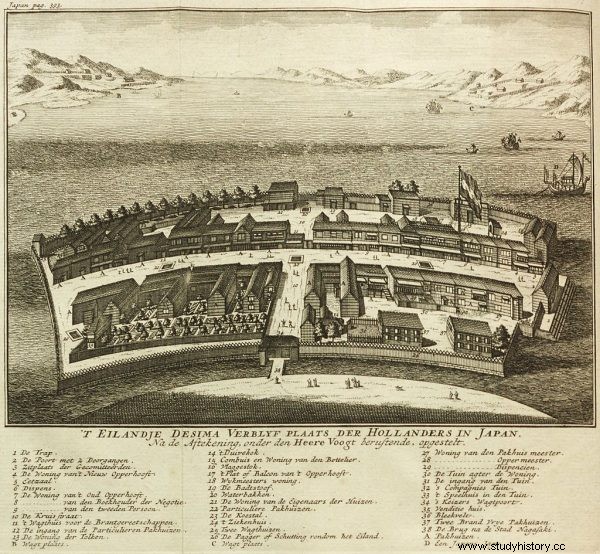
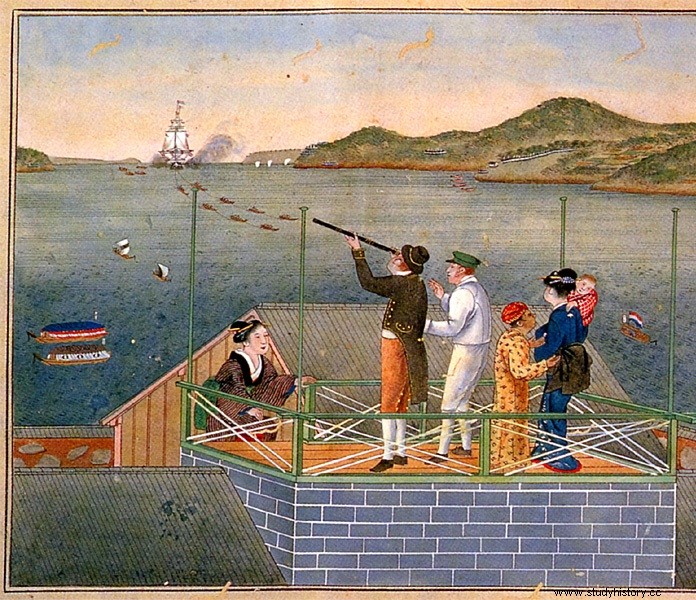
In Dejima, contact with the female sex remained limited and only to prostitutes, who also served as domestic helpers. Public confession of the Christian faith – you are beginning to suspect – was forbidden. Bibles and other Christian writings were put in barrels and sealed when a Dutch ship arrived, and even a deceased was not allowed to be buried on Japanese soil, but instead received a grave in sea, off Nagasaki. To guard against a possible revolt, weapons and ammunition were also confiscated until the departure of the said occupants. These restrictions (with the exception of the aforementioned seaman's tomb) will last until 1850. On the other hand, these restrictions made Dejima the safest trading area in Asia and especially in the early years , the Dutch made considerable profits on the trade.
If the Dutch counter was particularly profitable for the VOC (Vereenigde Oost-Indische Compagnie, in other words the Dutch East India Company), with its commercial monopoly, Japan also owes a lot to the Dutch on Dejima. And for good reason:the Dutch ships brought books and other information that allowed Japan to learn more about the outside world and, in particular, to become familiar with emerging European science.

Rights, duties and gifts
Japanese authority rhymes with meticulousness. In Dejima, contact with the female sex was limited only to prostitutes, who also served as domestic help. Public confession of the Christian faith was prohibited. Bibles and other Christian writings were put in barrels and sealed on the arrival of a Dutch ship, and even the deceased was not allowed to be buried on Japanese soil, but was given the grave of a marin.off Nagasaki. Weapons and ammunition were also confiscated until departure. These restrictions (with the exception of the Sailor's Grave) will last until 1850.
While the Dutch have however had the privilege of having an audience with the shogun in Edo each year, it is customary to offer to bestow gifts on him and on senior government officials. The first trip to court was in 1609 and from 1633 it was an annual event. When the Dutch were transferred to Dejima, the trip to court was sometimes a welcome change from the usually boring life on the island, but instead of a privilege, the trip to court became a burden over time, partly because there were quite a lot of costs involved (including presents to bring), and partly because the tedious journey to cover was around 2,000 km. To give an idea:a trip to the court lasted about three months, including two to three weeks within the court.
The shogun submitted a wish list in advance, the so-called requirements of the emperor, moreover describing in detail the expected gifts, minus the surprise. Tokugawa Ieharu, for example, commissioned three Persian stallions in 1765 who were to be no more than nine years old and well trained. Typical gifts included textiles (silk), watches, telescopes, books, exotic animals and curiosities of all kinds. The shogun gave 30 traditional kimonos as a return gift. The shogun's wish list for the annual court trip regularly included books and scientific instruments, such as telescopes or barometers.
The pace of the trading year was determined by the ships sailing from Batavia to Dejima. At the end of June each year, two or three ships leave for their month-long voyage to Dejima, after which they trade for about three months. Then, from the end of October to mid-November, the registers are established. The chief delegates his functions to his successor who came with the ships of Batavia. Then the ships return to Batavia where they arrive towards the end of the year. As soon as the ships leave Dejima, the trip to the court is prepared on the island, which is then carried out in the spring (from February to May). As soon as the trip to the court is over, preparations are made for the next business year from May to August.
In addition to silk, wood, skins, lead, mercury, tin, sugar, spices, textiles and raw materials were imported from Asian trade. Japan itself exported silver, gold, copper, camphor, sake, and soybeans. Products that came from Europe were used as gifts during journeys to the court, and books and scientific instruments were also imported for trade in Japan. Copper and especially Japanese silver gave the Dutch in this Asian region a significant trading advantage over other European nations, who had to import silver from other parts of the world. However, Japan banned silver exports in 1668.
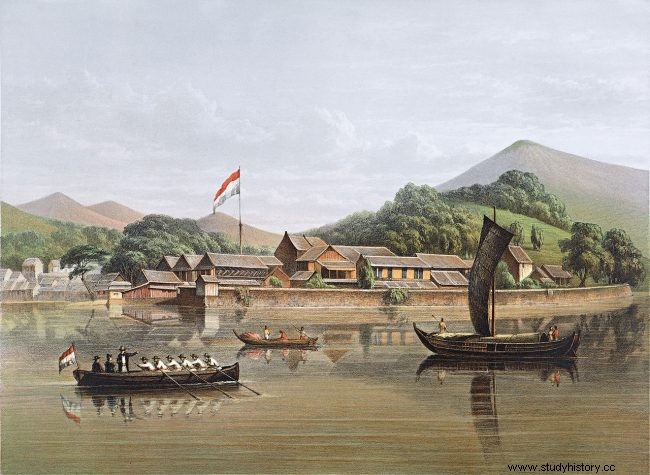
Exchanges
Several Japanese who had to keep an eye on the Dutch, the interpreters or even envoys of the shogun, began to translate Western books. This was all the more desirable for them given that during the 18th century the ban on importing foreign goods was introduced. The turning point will come in 1774 when some Japanese scholars published the anatomical work of the human body by Johann Adam Kulmus. After this publication, many other works appeared in translation. Between 1798 and 1802, Newton's theories were presented there. History, art, politics, works follow one another and questions accumulate. In the 1840s, the first biographies of Napoleon landed to never leave the amazement of the Japanese against the simple soldier who became emperor.
The translation work was accompanied by publications of various dictionaries and studies of the Dutch language. In fact, bridges between the West and Japan were established without it being officially proclaimed, and a certain number of Dutch words were introduced into the Japanese language following “Rangaku” (literally “Dutch studies”) . These are often words for which there was no equivalent in Japanese, but sometimes the Dutch words have supplanted the Japanese variant. In 1615, “Kokku” (from the Dutch word “kok/koken”, meaning to cook) is the oldest Japanese word copied from Dutch.
In a jumble, several cultural objects or products delighted the astonished gaze of the Japanese. What about the pleasant game of badminton, the elegance of billiards or the undeniable charm of the notes played on a piano? Even more, the dishes at the table of the Dutch agitate the taste buds:coffee, beer, parsley, white cabbage, tomatoes and chocolate. And between two courses, we wonder about the brick, the buttons of the jackets or quite simply the painting of the pictures.
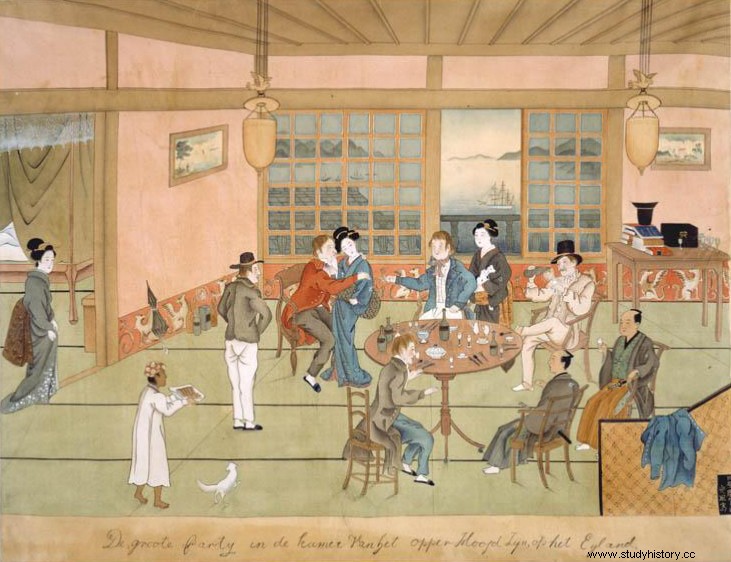
The Kusumoto Ine case
Kusumoto Ine was the daughter of the German doctor Philipp Franz von Siebold who settled in Dejima to work there. She was born of a union with Kusumoto Taki, a courtesan from Nagasaki. Her journey was a winding one, but in the end she had the privilege of being the first female doctor using Western techniques in Japan.
Siebold was banished from Japan in 1829, but managed to support Ine and her mother and arranged for his students and associates to care for them. Anxious not to leave them destitute, Siebold gave Taki and Ine a supply of sugar (very precious at that time) to meet their daily needs.
Ine's reputation grew after she became a doctor of Western medicine, and she gained the patronage of feudal lord (daimyo) Date Munenari. She studied in various parts of Japan with many teachers, one of whom got her pregnant - likely rape - resulting in her only daughter, Takako. She never married thereafter. Settled in Tokyo after the country ended its isolation, Ine assisted in the birth of one of Emperor Meiji's concubines in 1873. Since her death, Ine, an extremely rare foreign female figure at the end of the 19th century in Japan, has been the subject of novels, plays, comics and musicals.

Nowadays
Today the site has been restored to the public as in 1798 many of the buildings were largely destroyed by fire. But Dejima, which was built as an artificial island, is no longer an island proper due to the construction of the mouth of the Nakajima River over eight years from 1883 and port improvement works carried out. for seven years from 1897.
Although he lost his form, Dejima does not remain an important vestige in the relationship between the West and Japan. Therefore, in 1996, the city of Nagasaki invested a huge amount of money to start a restoration project for the entire site. In addition, the presence of the Dutch has become part of the local folklore.
The first priority was to restore the structures to show the state of daily life and commerce at that time, then to restore the houses and warehouses. Particular care has been taken to represent as faithfully as possible the lifestyle of local officials, but also, more prosaically, to improve the streets and urban facilities to make accessibility more comfortable. If the short-term plan was to make it a small town again, the long-term plan is to completely restore it as a fan-shaped island surrounded by water on all sides.
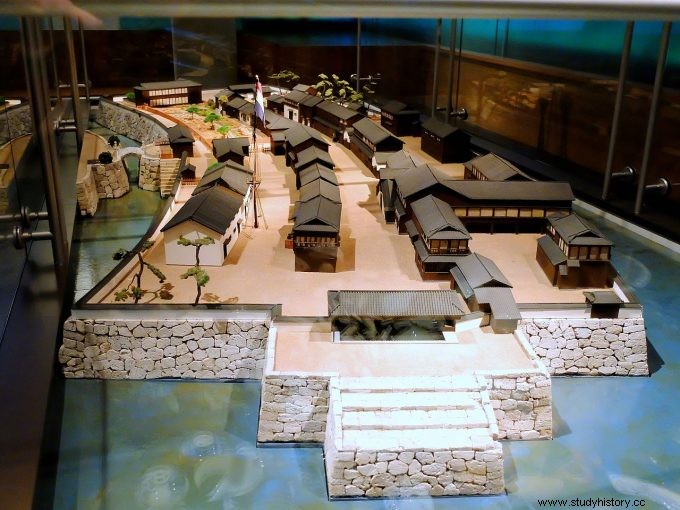
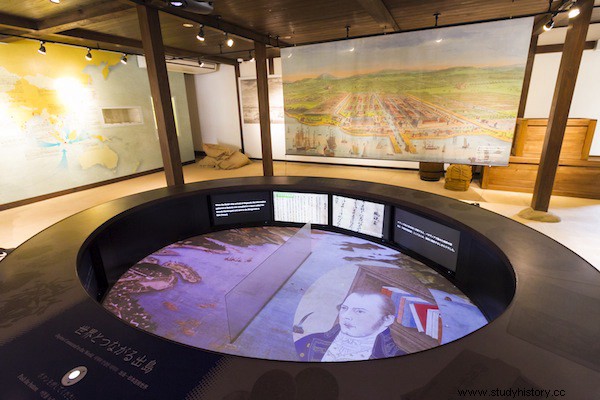
Sources and references
Nagasaki-Dejima.jp
Cairn:The Dejima Island Experience
Persee Dejima
Diary relating to the Dutch, dated February 14, 1641 – October 31, 1641. Historiographical Institute University of Tokyo
Universalis:Japan
Modern without being Western. On the origins of today's Japan, a book by Pierre François Souyri
